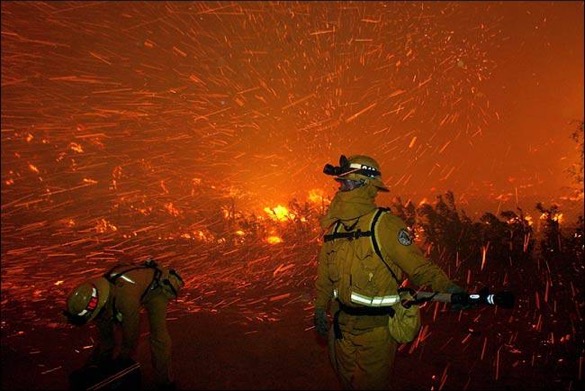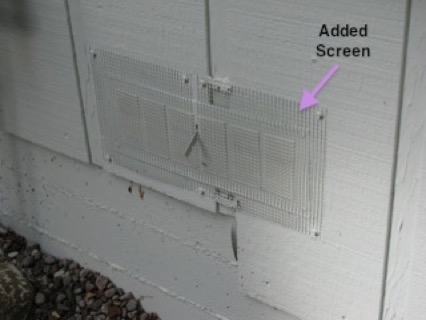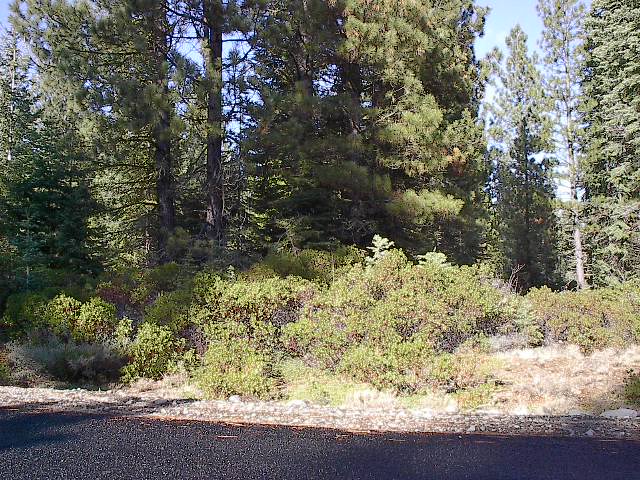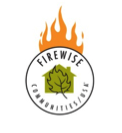This page contains a series of brief discussions of selected common Firewise issues along with some practical solutions for property owners. Just scroll down the page to find the topic of interest. Currently, the list includes:
- Ember Intrusion
- Fuel Ladders & Tree Limbing
- Shrub Spacing
- Firewood Storage
------------------------------------------------------------
EMBER INTRUSION
Embers are a primary cause of structure ignitions. As shown in the photograph below, those glowing particles get pushed by the wind well in advance of the actual fires. If they settle on combustible materials they can ignite new fires. They can even get blown INTO a structure through open windows, open doors and unscreened vents. If they should come to rest in your crawl space or attic, you may not have any indication of a problem until a fire is well underway.

Homeowners can prevent ember intrusion by keeping windows and doors closed when a fire is near and by making sure that attic and crawl space vents are properly screened or otherwise equipped with ember protection. Screening should be metal (not fiberglass) and should have openings that are not larger than 1/4 inch (1/8 inch is even better). If you find that the current openings are larger than you would prefer on your home, there is a simple solution: add another layer of finer screen to the vent. Just cut a piece of screening a little larger than the vent and then attach it to the structure using staples or screws.

A re-screened crawl space vent.
-------------------------------------------------------------------------------
FUEL LADDERS & TREE LIMBING
A "fuel ladder" is any combination of dry grass, brush or small trees that would allow a fire on the surface to work its way into the upper foliage (crowns) of mature trees. This is something to avoid because it poses a significant threat to trees and ultimately to structures. The photo below shows an example of a dangerous fuel ladder, with vegetation and foliage starting at the surface and running continuously into tree crowns.

The way to get rid of fuel ladders is to interrupt the chain of combustible material from the surface. Put more simply:
(1) Remove the dry grass, brush and debris from beneath trees, and
(2) Remove the lower limbs of trees.
There needs to be at least 6 feet of clearance between the surface and the lowest limbs of trees. Here's a simple test: you should be able to walk under your mature trees without having to stoop. On small trees (less than 18 feet tall) just remove the lower 1/3 of the branches. The good news is that the lower branches don't grow back, so you won't have to do this on the same tree year after year.

-----------------------------------------------------------------------------------
SHRUB SPACING
Many homes at Bailey Creek have shrubs in their yard, some being non-native ornamental plants while others are native Manzanita or white thorn. Each shrub has the potential to turn into a true burning bush in the event of fire, which leads to a need to ensure that they are positioned safely so that they don’t pose a threat to structures or other vegetation. All shrubs should be kept away from trees, well clear of propane tanks and at least several feet from structures; just ask yourself if you would be comfortable if that bush was blazing away! Junipers and Manzanita tend to ignite easily and burn vigorously, so be especially careful with them. CalFire offers a simple guideline for shrub spacing in your yard: the distance between shrub foliage should be at least twice the MATURE height of the tallest shrub.
-------------------------------------------------------------------------------------
FIREWOOD STORAGE
Anyone with a wood-burning appliance knows that trudging through the snow to get to the firewood pile in winter is a real chore. So the temptation is to stack firewood as close to the house as possible. Unfortunately, embers from wild land fires seem to seek out firewood piles and embed themselves in those many little nooks and crevices, eventually igniting the whole pile. CalFire therefore recommends that you store your firewood at least thirty feet (30’) from any structures. However, if that isn’t possible, then your only recourse is to completely wrap the stack in a fire-proof cover such as fine mesh, metal screen door screening. Don’t leave any openings for embers!
-------------------------------------------------------------------------------------
